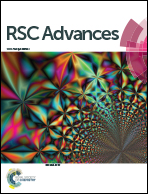A high-performance ambipolar organic field-effect transistor based on a bidirectional π-extended diketopyrrolopyrrole under ambient conditions†
Abstract
A novel bidirectional π-extended 2,5-dihydro-1,4-dioxo-3,6-di-2-thienyl-1,4-diketopyrrolo[3,4-c]pyrrole derivative (DPP-2T) with the 4-(2,2-dicyanovinyl)phenyl group, (DPP-2T2P–2DCV), has been synthesized and characterized in order to achieve a high-performance organic semiconductor. The HOMO/LUMO energies of DPP-2T2P–2DCV were estimated to be −5.36 and −3.81 eV, respectively, based on their redox potentials, which were very similar to the other bidirectional π-extended DPP-2T analogue DPP-4T–2DCV. The calculated HOMO/LUMO values (HOMO: −5.43 eV, LUMO: −3.56 eV) based on the optimized geometry agreed well with the experimental values. DPP-2T2P–2DCV exhibits ambipolar TFT response with reasonably balanced electron and hole mobilities of 0.168 cm2 V−1 s−1 and 0.015 cm2 V−1 s−1 by solution process, respectively, which is the best result for solution processable DPP-based ambipolar small molecule semiconductors measured under ambient atmosphere.


 Please wait while we load your content...
Please wait while we load your content...